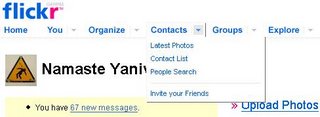5 things & 5 taps
You can see this happening all over the place, with Flickr being a prime example. There are so many different "games" taking place on Flickr at any given time, usually involving tagging and groups. These games spread informally, through one person virtually tapping the virtual shoulder of another, usually accompanied with a link that explains what the game is about. The game entry barriers are very low – tag your own stuff or someone else, post a comment with a pre-agreed template, etc.
Now there is a game spreading through the blogosphere, and my shoulder has been tapped by the wonderful Deborah Schultz. And in the spirit of the game, I will now proceed to tell you five things you may not know about me, and then tap the virtual shoulders of five other bloggers:
1. I often forget my own phone number, but I remember the value of PI up to the 8 decimal digit. Go figure.
2. I am not good with backups of my personal stuff. This just cost me $2300 (hard disk recovery fees) last week.
3. I love what I do. But if I couldn't do what I do, I'd want to be an architect.
4. By the time I finish reading the time from an analog watch, it's usually already at least 1 or 2 minutes past the time I started trying to read it.
5. I love good movies - or any movie, no matter how bad it is, that contains anything that can be labeled Sci-Fi or Fantasy.
Tap time:
Tara Hunt, Eszter Hargittai, Derek Anderson, Kaliya Hamlin, Uri Baruchin














